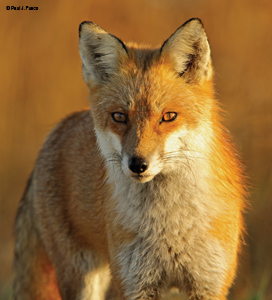Red Fox
Vulpes vulpes
Background
The red fox is widespread and abundant in Connecticut. The population that exists today is made up of hybrids, a result of interbreeding between native red foxes and the European red fox, which was introduced into the eastern coastal areas of the United States in the mid-18th century. The native red fox was a boreal species that historically occurred in the northern regions of North America and at higher elevations (montane areas) in western areas. Foxes are members of the dog family, Canidae, just like domestic dogs and coyotes.
Range
Red foxes occur over most of North America from Baffin Island, Canada, and Alaska to the southern United States, except for coastal western Canada, Oregon, and California, the Great Plains, the southwestern desert and the extreme southeastern United States.
Description
The red fox is best identified by its reddish coat, black legs and ears, and long, white-tipped, bushy tail. It has an elongated muzzle, pointed ears, and a white underside. Other color phases are uncommon but include silver, black, and a cross, always with a white-tipped tail and dark feet. The tail is proportionally longer than the tail of a coyote and, when the fox is running, it is held horizontally behind the animal. Red foxes weigh between 7 and 15 pounds, averaging 10 to 11 pounds, and measure between 39 and 43 inches long, including the tail. Males are slightly heavier and generally larger than females.
The gray fox, which also is found in Connecticut, is often confused with the red fox because of the rusty red fur on its ears, ruffs, and neck. Although somewhat similar in size, the gray fox has a gray coat, with a whitish belly, throat, and chest, and a shorter muzzle and ears. It also lacks the white-tip on the tail exhibited by the red fox.
Habitat and Diet
Red foxes prefer to inhabit a mixture of forest and open fields. They use the transition zone or "edge" between these habitats as hunting areas. Suburban and urban areas are commonly inhabited.
The red fox is an omnivore, meaning that it eats both plant and animal foods. Food items include small rodents, squirrels, woodchucks, rabbits, birds and eggs, amphibians, and reptiles. Foxes also will eat vegetation, fruits, nuts, insects, carrion, and garbage. Red foxes may partially bury, or cache, excess food, cover it with soil, grass, leaves, or snow, and mark it with urine.
Life History
The breeding season is from January through March. After a gestation period of 51 to 53 days, females give birth to a litter averaging 4 or 5 pups. Red foxes may dig their own burrows but they usually improve an abandoned woodchuck burrow. It also is common for foxes to den in the crawl space under decks and sheds. Most foxes have more than 1 den and will readily move their young if disturbed. The pups stay in the den until they are about 4 to 5 weeks of age, after which they emerge and begin to play outside the den entrance. Both adults care for the young by bringing food and guarding the den site. The pups are weaned at about 12 weeks and join the adults on hunting forays, learning to catch food on their own. The young disperse from the family unit in fall and will usually breed during their first winter.
Interesting Facts
Red foxes tend to be solitary, usually hunting alone. They can be active at any time of day, but appear to hunt most often during dawn and dusk. It is not unusual to observe foxes during daytime. They remain active all year and do not hibernate. The normal home range for a fox is about 2 to 4 square miles in Connecticut, but it may vary depending on the abundance of food.
Foxes are quite vocal, exhibiting various barks, howls, and whines. The sounds vary from a short, sharp "yap" or bark, followed by a "yap, yap," to a combination of screeches, yells, and long howls. A common report to the DEEP Wildlife Division involves the sounds made by red foxes (e.g., a raspy, single syllable scream or bark, repeated regularly every 3-10 seconds).
Foxes are important predators of prolific prey species like mice, rats, and rabbits. Adult foxes have few predators, although coyotes likely will not tolerate foxes within their territories. Several studies have found that red foxes only occur in the gaps between the larger territories of coyotes. The relatively recent expansion of coyotes throughout Connecticut may have displaced red foxes from much of their prime habitat.
Foxes can carry the organisms that are responsible for several contagious diseases, such as mange, distemper, and rabies. Sarcoptic mange is sometimes deadly to foxes and coyotes. It is caused by a microscopic mite that lives in the skin. Animals with mange lose hair and weight; their skin becomes cracked and encrusted with heavy scabs. Infected foxes usually die from the affliction within 2 to 4 months. Humans can contract the mite from infested coyotes, foxes, and dogs, but the disease is less intense, consisting of a mild form of dermatitis.
Raccoon rabies is the most common strain of rabies found in Connecticut. Raccoons are the primary carrier but foxes also can be infected. Foxes are the primary carrier of different strains of rabies that occur in other regions of North America. Most red foxes die from rabies too quickly to spread the disease to other animals or humans. Nevertheless, animals that appear sick or are acting abnormally should be avoided. The following symptoms may indicate the presence of rabies or other neurological diseases in mammals: unprovoked aggression, impaired movement, paralysis or lack of coordination, unusually bold behavior, and disorientation. The local animal control officer or police should be contacted if assistance is needed with a potentially rabid animal. If you are unable to contact local authorities, call DEEP's 24-hour Dispatch Center at 860-424-3333.
Living with Foxes
Foxes commonly live in close association with human residences and communities where they can find plenty of food, water, and cover. They frequently inhabit yards, parks, and golf courses, especially areas that adjoin suitable, undeveloped habitat. Foxes can become accustomed to human activity but are seldom aggressive toward people. Problems associated with foxes include depredation on domestic animals, perceptions of danger to humans (healthy foxes pose virtually no danger to humans), and their potential to carry disease organisms. The mere presence of a fox should not be perceived as a problem and foxes need not be feared. However, those who are uncomfortable with the presence of foxes can take certain actions to reduce the chance of problems:
Do not allow pets to run free! Keep cats indoors, particularly at night, and small dogs on a leash and under close supervision at all times.
NEVER feed foxes! DO NOT put out food for any mammals. Feed pets indoors. Clean up fruit dropped from trees and bird seed below feeders. Secure garbage in animal proof containers and store in a garage or shed. Feeding, whether direct or indirect, can cause foxes to act tame and may lead to bold behavior over time.
Close off crawl spaces under decks and sheds. Foxes will use these areas for resting and raising young.
Protect livestock. Foxes will prey on small livestock, such as ducks, chickens, rabbits, and young lambs, but generally do not bother larger livestock. Livestock can be protected with secure pens, coops, or fencing. Make sure the enclosures prevent entry from above and below as foxes will dig or squeeze under poorly maintained fences and may climb over small fences. Most predation occurs at night so it is particularly important to provide protection at that time. Some electric fence designs can provide good protection.
Use frightening techniques. Human presence often is a deterrent to foxes. Foxes that travel into residential yards can be harassed or scared with loud noises, bright lights, or spraying water from a hose. Disturbing a den site physically or with unnatural odors during spring may prompt foxes to move to another den which may be farther away.
Trapping and Hunting
Foxes are classified as furbearer species, and thus Connecticut has established regulated hunting and trapping seasons. Hunting and trapping can be used to regulate fox populations while providing recreational opportunities for sportsmen and women. Nationally, millions of dollars are generated every year from fox pelt harvests. The silky, dense fur of the red fox is more valued than the fur of the gray fox, which is coarse and thin. Live-trapping and relocating foxes is not recommended because the state's fox population and fox "problems" are widespread, and relocated foxes can cause problems in new locations. Removing problem foxes through trapping or hunting is only recommended during designated seasons or in situations where individual foxes show a pattern of preying on livestock.
 This publication is partially funded by the Federal Aid in Wildlife Restoration Program. Funds are provided through an excise tax on the sale of sporting firearms, ammunition, and archery equipment. (rev. 5/2018)
This publication is partially funded by the Federal Aid in Wildlife Restoration Program. Funds are provided through an excise tax on the sale of sporting firearms, ammunition, and archery equipment. (rev. 5/2018)

